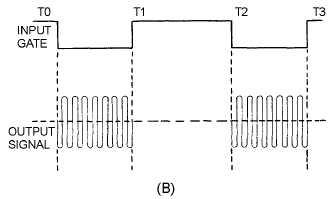2-29
Figure 2-25B.—Pulsed oscillator.
The waveforms in view (B) show the relationship of the input gate and the output signal from the
pulsed oscillator. To see how this circuit operates, assume that the Q of the LC tank circuit is high enough
to prevent damping. An output from the circuit is obtained when the input gate goes negative (T0 to T1
and T2 to T3). The remainder of the time (T1 to T2) the transistor conducts heavily and there is no output
from the circuit. The width of the input gate controls the time for the output signal. Making the gate wider
causes the output to be present (or ring) for a longer time.
Frequency of a Pulsed Oscillator
The frequency of a pulsed oscillator is determined by both the input gating signal and the resonant
frequency of the tank circuit. When a sinusoidal oscillator is resonant at 1 megahertz, the output is 1
million cycles per second. In the case of a pulsed oscillator, the number of cycles present in the output is
determined by the gating pulse width.
If a 1-megahertz oscillator is cut off for 1/2 second, or 50 percent of the time, then the output is
500,000 cycles at the 1 -megahertz rate. In other words, the frequency of the tank circuit is still 1
megahertz, but the oscillator is only allowed to produce 500,000 cycles each second.
The output frequency can be determined by controlling how long the tank circuit will oscillate. For
example, suppose a negative input gate of 500 microseconds and a positive input gate of 999,500
microseconds (total of 1 second) are applied. The transistor will be cut off for 500 microseconds and the
tank circuit will oscillate for that 500 microseconds, producing an output signal. The transistor will then
conduct for 999,500 microseconds and the tank circuit will not oscillate during that time period. The 500
microseconds that the tank circuit is allowed to oscillate will allow only 500 cycles of the 1-megahertz
tank frequency.
You can easily check this frequency by using the following formula:
One cycle of the 1-megahertz resonant frequency is equal to 1 microsecond.




